“She enjoyed that way too much.”
“Tell me about it.”
– Clara Oswald, RIP (for now)
Of course a season of two-parters would end with a three-parter.
That said, it seems quite clear that Face the Raven is the first part of a three-parter in the same way that Utopia was the first part of a three-parter; it is largely a standalone story that exists to manoeuvre the various characters to the point where the season finalé can actually begin. In a way, Face the Raven even marks its own “return of a classic series element”, albeit in a much more subdued manner than Utopia. It seems quite clear exactly who Ashidlr is dealing with, and it seems to be a pretty big deal.

Quoth the raven…
There is quite a lot of narrative shuffling taking place here, to the point that Face the Raven feels very much like a premise rather than a self-contained story. The episode was allegedly cobbled together at reasonably short notice when Mark Gatiss could not extend Sleep No More into a two-parter keeping with the rest of the season. Given all the demands imposed on the script, it seems perfectly reasonable to suggest that Sarah Dollard was handed what is traditionally known as a “nightmare brief.”
In light of all of the obligations imposed on it, it is surprising that Face the Raven works at all. It is even more impressive that it works downright splendidly.

… nevermore…
Face the Raven is not really a story, in the same way that Utopia is not really a story. It is a framework for an interlocking series of concepts tied together like a daisy chain while building towards a surprising cliffhanger. While there is something loosely resembling an overarching plot driving the action – mankind wanting to reach “Utopia” in Utopia and the Doctor trying to prove Rigsy’s innocence in Face the Raven – the episode is more about storytelling sleight of hand. The audience is invited to watch the cups move.
After all, Face the Raven (like Utopia before it) would feel quite light without the cliffhanger. It would be entertaining and populated with interesting ideas, but the climax of the story is handily backported from the epic two-part season finalé. The climax of Face the Raven does not belong to this story alone in the way that the climax of The Zygon Inversion or Before the Flood is particular to those stories. No matter what actually happened in Face the Raven, the episode would always end with the Doctor’s abduction and Clara’s death.

Brace(let) yourself…
The only question is how the story plans to get there. With Utopia, Russell T. Davies scripted a mood piece in which the show could get away from the standard epic (and ever-expanding) doomsday scenarios to tell a quieter story about the death of mankind that seemed largely at odd with the aesthetic of Doctor Who. With Face the Raven, Sarah Dollard keeps throwing clever concepts at the screen in order to fill the available airtime. Knowing where the script must inevitably go, Face the Raven is able to luxuriate in getting there.
While the climax of Face the Raven will inevitably dominate discussion of the episode, the first two-thirds of the story are fascinating in their own right. The fact that the climax is fixed means that Face the Raven has a certain degree of freedom in manoeuvring the Doctor and Clara to that point. Face the Raven takes its time to play with concepts that would get squeezed aside in a more plot-driven episode, spending fifteen minutes on the concept of the secret geography of London and fifteen minutes on the workings of an alien refugee camp.

Mapping out the season…
In any other episode, these would be simple storytelling set-up; the scripts would be expected to establish them quickly and cleanly so that the rest of the story could move along from that basic premise. The Doctor would mention the concept of a hidden street, and then do some tech-sounding thing that allowed the TARDIS to move along so the story could continue. The TARDIS would land inside an alien refugee camp, and the Doctor would explain the concept to Clara before the actual plot kicked into gear.
Without an actual plot, Face the Raven is free to enjoy these ideas. The pleasure that the show takes in them, and the fact that they are simply a path to the climax rather than a plot of their own, allows for some blatant homaging from the show. When Clara explains the purpose of “trap streets” to the Doctor and Rigsy, the Doctor cheekily responds, “My God, a whole London street just ups and disappears, and you lot assume it’s a copyright infringement.” Of course, there is a sense that Face the Raven is having a bit of fun at its own expense.
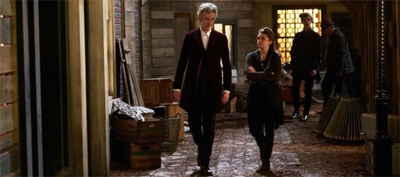
Where the streets have no names…
The basic concept of the “trap street” will seem familiar to the young adult audience who enjoy Doctor Who. John Green employed the concept in his young adult novel Paper Towns. While “trap streets” are imaginary streets that serve to safe-guard urban maps from copyright infringement, “paper towns” are fictitious towns that serve the same purpose for more rural maps. The idea is that if a map is copied, the cartographers have a way of proving that it is their work. In its own way, the same is true of Face the Raven.
More than that, the actual design of the trap street as an intersection between modern London and a more nostalgic depiction of old-world charm cannot help but be informed by Harry Potter. J.K. Rowling’s series offers one of the most enduring and popular depictions of a “secret” London existing just beyond the mundane. Of course, Harry Potter does not have a monopoly on such concepts. Even Doctor Who has a long history charting the imaginary spaces of the urban environment, from Yeti-infested tube stations to Cybermen lurking under St. Paul’s Cathedral.

It’s just not on the cards…
It would be churlish to describe any of these homages or references as “copyright infringement”, as much as the Doctor might employ the term. After all, “trap streets” and “paper towns” are real concepts that represent an intriguing intersection of the real and the unreal; Paper Towns and Face the Raven employ them in their own ways. Similarly, the basic concept of a “hidden” London endures in popular culture and belongs to Doctor Who just as much as to Harry Potter, in spite of how many of its cues Face the Raven might take from Rowling’s series.
There is something quite charming in seeing Doctor Who take the time to properly play with these ideas that would be reduced to footnotes in another story. After all, the urban fantastic has been a recurring motif throughout the show, perhaps a spiritual continuation of those stories about the fair folk and enchanted realms existing just beyond the boundaries of human perception. “Forget the way you usually look at the world,” the Doctor advises Clara and Rigsy, perhaps a distillation of the romance of Doctor Who.
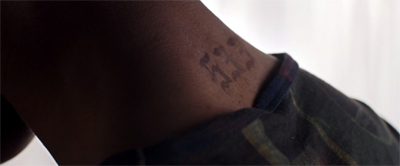
Countdown…
In keeping with the aesthetic of the Moffat era, the uncanny becomes the fantastic. Trivial everyday occurences point to some deeper hidden meaning. “When you hit an area around a trap street, you’ll very likely lose count,” the Doctor urges his companions, much like the monsters that lurk in the corner of the eye. As fantastical and absurd as the show might be, Doctor Who embraces a magical realism anchored in relatable experience. The Doctor even compares finding a door to a secret world to trying to “read the same very simple sentence three times over.”
One of the advantages of being a relatively last-minute script means that Face the Raven has the luxury of seeming quite timely. The Zygon Invasion and The Zygon Inversion represent the strongest episodes of the season, embracing a current cultural crisis through allegory and metaphor. Although Face the Raven is not constructing a story so much as stalling before a climax, the script is able to build in some very timely and powerful themes. In many ways, the alien refugee camp setting provides a counterpoint to The Zygon Invasion.

A sad stasis of affairs…
Ashildr is positioned as a warden overseeing a space where alien refugees are kept separate from mankind. Given the current Syrian refugee crisis and other anxieties about “the alien”, the concept is quite timely. The larger discourse opened by the Paris terror attacks and Donald Trump’s “Muslim database” suggest that Face the Raven has become even more timely than it was when it was originally scripted and shot. “What’s better?” Ashidlr asks. “That they’re in here with me – peaceful and cooperative – or out there on Earth like the Zygons?”
It is worth noting that camp pointedly includes races that are known for their aggression; both Sontarans and Cybermen seem to have sought asylum in the camp. However, Face the Raven also includes all manner of other loaded symbolism and dialogue. The central premise of the episode features Rigsy waking up after visiting a “refugee camp” to find a number tattooed on him. It is not the most subtle of visual metaphors, but seems quite pointed in a world where Donald Trump can’t explain how his “Muslim database” differs from Nazi policies.
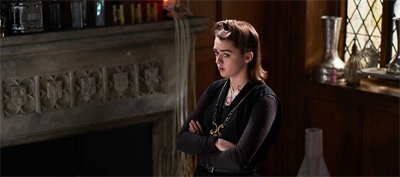
Me time…
As with The Zygon Invasion and The Zygon Inversion, Face the Raven suggests that the refugee crisis is part of a larger anxiety about “the Other.” Ashidlr justifies the harsh policies by stressing the importance of safety and control. “Our rules keeps us safe,” Ashidlr explains. “You think a Cyberman fears a peaceful death?” One of the residents justifies the hatred towards Rigsy as something that ties the community together. “You don’t get it, do you? If the human didn’t do it, that means one of us did it. Which means folks start pointing fingers, turning on each other.”
These details are largely about fleshing out the world, rather than driving a plot. The murder mystery that lured the Doctor and Clara to the street is not a murder mystery at all; as the Doctor discovers, the victim is not even dead. This means that the dialogue and conversations are largely driven by thematic concerns and social commentary. The Doctor and Clara’s interrogation of the residents is not about proving what happened, it is about establishing tone and context. After all, the end of Face the Raven was set before the rest of the plot was conceived.
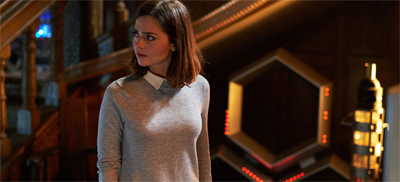
Time is up…
It is worth commenting on that ending. Face the Raven takes great care to avoid specifically mentioning the words “Time Lords” or “Gallifrey”, but the script cleverly suggests that Ashidlr’s betrayal of the Doctor is related to the inevitable return of the Doctor’s home planet. Indeed, one of the residents of the street reflects that he “might as well be back in the Warzone.” While a seemingly innocuous turn of phrase, it could also be a nod to The War Games, the story that introduced the Time Lords in the first place.
In keeping with the broad themes of the Moffat era, memory and continuity entangle once again. In her reintroduction to the Doctor and Clara, Ashidlr restates her own “infinite life, finite memory” as a justification for the character’s lack of internal continuity; if Ashidlr cannot remember who she is, can she possibly be the same character from The Girl Who Died and The Woman Who Lived? While The Magician’s Apprentice and The Witch’s Familiar suggested that memory can be a trap, Face the Raven suggests memory is also essential to identity.
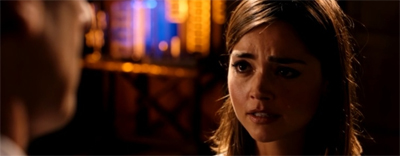
“Promise me you’ll remember me more fondly than Adric…”
That said, Face the Raven is just as cautious about continuity as The Magician’s Apprentice was. In The Magician’s Apprentice, it was suggested that Davros’ memory served to give him power over the Doctor. It is no coincidence that the “confession” introduced early in The Magician’s Apprentice comes back into play at the climax of Face the Raven. The Doctor’s past is coming back to haunt him, in a very literal way. Indeed, the “trap street” in Face the Raven is largely sprung on the Doctor through manipulation of continuity.
Continuity plays a large part of Face of the Raven. The episode features two returning guest stars from the Capaldi era. Joivan Wade returns as Rigsy from Flatline and Maisie Williams returns as Ashidlr from The Girl Who Died and The Woman Who Lived. It could be argued that Ashidlr’s reappearance is largely unnecessary; the “mayor” of the “trap street” could just as easily be a new character and still serve the story. However, the Doctor’s history is part of the trap. Ashidlr targets Rigsy precisely because he is a figure from the Doctor’s past. He is weaponised continuity.

Night mayor…
Indeed, Face the Raven suggests that past and future are intertwined; this certainly seems appropriate for a show about a time traveller. The Doctor encounters a race of female psychics, perhaps a nod towards the Sisters of Kairn. “One face sees into the future,” he explains to Clara. “The other looks behind her into the past.” It seems that both must ultimately be integrated into the self. One of these psychics warns the Doctor, “I can’t tell your past from your future, and there’s so very much of both.”
Again, Doctor Who deals with its own continuity through the prism of memory. When dealing with fifty years of contradictory continuity, memory serves as a very vital tool. It is difficult, for example, to reconcile the versions of Gallifrey that appeared in The War Games and The Deadly Assassin and The Five Doctors, but it becomes a lot easier when memory is used as a guide rather than literal continuity. The Zygons featured in The Zygon Invasion and The Zygon Inversion may differ from those in Terror of the Zygons, but they hew close to the memory.

Heal thyself…
The reintergration of Gallifrey into the mythos of Doctor Who represents a very clear challenge to the show. After all, memory suggests that Gallifrey is important and essential, even if history suggests just the opposite. Gallifrey was so inessential to the show that it did not appear until the final black-and-white story at the end of the Second Doctor’s era; it was so hazily defined that depictions of Gallifrey and Time Lords differed dramatically between The War Games and Terror of the Autons and The Deadly Assassin.
Most obviously, it remains hard to get around the fact that vast majority of Gallifrey stories (from The Three Doctors to Arc of Infinity to The Trial of a Time Lord) were quite terrible. The concept’s history would meditate against the return of the Time Lords; after all, experience suggests that the concept of Gallifrey works better as a tragic detail than a physical location. Nevertheless, memory suggests that Gallifrey is important and essential. So memory demands that Gallifrey be addressed. Hell Bent and Heaven Sent thus represent a challenge to the Moffat era.

The game is Rigsy’d…
The death of Clara Oswald is a nice structural twist at the end of Face the Raven. After all, Jenna Louise Coleman’s departure at the end of the season had announced long ago; audiences would have expected a death scene or a departure scene in Heaven Sent. While it seems quite clear that the actress will be back for Heaven Sent, slotting a death scene into Face the Raven is a very canny move on the part of the production team. It is an effective exploitation of the structure of the season and the expectations that flow from that.
It is similar to the decision to have a Dalek shoot the Tenth Doctor at the climax of The Stolen Earth. Given that most of the character’s scenes in Journey’s End were shot on soundstages and the fourth season had been announced as David Tennant’s last full season in the role, there was just the tiniest possibility that Russell T. Davies might actually have pulled a regeneration mid-finalé. Of course, it was all a clever ruse, but it was a ruse predicated on the televisual literacy of the audience; it counted on the audience knowing that a surprise regeneration was just about possible.

Last teleport of call…
The death of Clara Oswald at the climax of Face the Raven is also just about plausible. After all, it is very near the end of the actor’s term in the role. Canny viewers already know that Peter Capaldi will be carrying Hell Bent single-handedly. It seems quite likely that a lot of the shooting on Heaven Sent took place on soundstages. While most particularly savvy commentators would point out that an appearance from Jenna Louise Coleman in Heaven Sent is all but assured, it is impossible to say exactly what form that appearance will take.
More than that, Face the Raven invests completely in its death sequence. Clara does not die quickly or suddenly, in a way that would suggest to the audience that Jenna Louise Coleman deserved a finer showcase or celebration. Clara gets to have a final conversation with the Doctor, gets to play the hero, gets to emulate her idol. The final conversation between Clara and the Doctor distils their dynamic down to a thesis statement on the character. There is bravado, there is selfishness, there is insecurity. In those final minutes, Clara is as complex as she ever was.

It’s all “me”, “me”, “me”…
Indeed, Clara’s death serves as a grim conclusion to her larger character arc. Although Clara has not received much development over the ninth season, her death builds on the idea of Clara-as-Doctor that built to her usurping Peter Capaldi’s eyebrows in the credits to Death in Heaven. Clara’s death in Face the Raven comes as a result of her attempts to play the role of Doctor. “Why can’t I be more like you?” Clara demands with all her justified self-righteousness. Of course, the reason Clara cannot be more like the Doctor is because she is a companion.
If the teased return of Gallifrey suggests the reassertion of the old order, it makes sense that the rigid boundaries between Doctor and companion should be reinforced. Clara might have been able to get away with playing the role of the Doctor in stories like Mummy on the Orient Express or The Girl Who Died, but that time has passed. The past is reasserting itself; the companion cannot presume to play the role in the narrative assigned to the Doctor. Clara’s death becomes a narrative penalty; there is a reason that Ashidlr describes her manoeuvre as a “cheat.”

Death is his most constant companion…
Clara is right, of course. This is not fair. The decision to punish Clara for doing the same thing that the Doctor always does is arbitrary and malicious. In the context of Ashidlr’s speeches about how harsh penalties exist to protect the old order, the death of Clara seems downright reactionary. Clara’s death might come as a result of her decision to play the hero, but the execution is malicious and mean-spirited. In that context, it seems highly unlikely that Heaven Sent will allow the execution to stand.
At the same time, it does offer a lovely scene between Clara and the Doctor. In many ways, Clara was introduced as a somewhat generic companion. Her character always seemed more hazily defined than companions like Amy and Rory or Donna. Indeed, The Name of the Doctor suggested that Clara was truly the archetypal companion; that Clara was seeded throughout history as the Doctor’s most faithful associate. When first introduced as part of the anniversary year, Clara harked back to classic “blank slate” companions like Jo Grant or Sarah Jane.

Ringing alarm bells…
Over the course of her run on the show, Clara was gradually sketched out. Her personality was never as rigidly defined as the more iconic or distinctive companions like Leela or Romana or Donna or River. Clara’s characterisation was more subtle than the defining traumas afforded to Amy Pond, her life less fleshed out than that of Rose Tyler. Nevertheless, through little details and performance choices, Steven Moffat and Jenna Louise Coleman fashioned a complex and nuance character from Clara.
That comes out in her final confrontation. Clara is bold and ambitious, clever and shrewd. However, Clara is also reckless and arrogant. Nevertheless, that bravado hides a deep-seated insecurity. “I know this is going to hurt,” she urges the Doctor as her time comes to an end, “but please be proud of me.” Clara needs approval; she needs people to recognise her as special and brilliant. This is a character flaw, but it is a very human character flaw. However, it has always been there, hiding behind the bluster and the confidence. Scared, but somehow more afraid to show it.
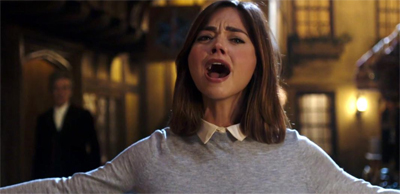
“What a shine.”
Face the Raven offers Clara a suitable farewell. If it is actually the farewell.
Filed under: Television | Tagged: characterisation, Clara Oswald, doctor who, face the raven, refugees |




















Great review. I’ve no idea how you manage to write these so fast!
I was thinking about the Zygon episodes while watching this and considering why they struck me as surprisingly conservative and downbeat for a fairly left wing show. I suppose it was that the Zygons have no real culture of their own; their technology is completely functional, we get no sense of their beliefs or values or even their language and entertainment. Even there forms are borrowed – the happy ending sees a Zygon take up the appearance, name and mannerisms of an existing human woman.
In some ways that makes logical sense for a race of shapeshifters but it makes them a difficult analogy with real life immigration and multiculturalism. The liberal view that the mixture of cultures is enriching in and of itself can’t really be supported by the show which needs the Zygons to disappear into humanity and the humans to forget most of what they do learn about them. In light of recent events it seems to me that is an edorsement (accidental or otherwise) of the French model rather than the British – assimilation over multiculturalism (with the American ‘melting pot’ being the middle ground maybe).
This episode meanwhile seems equally downbeat, with the aliens only being able to exist on Earth with a hidden place to be themselves (and even there adopting human trappings and guises). I was reminded of ‘Buffy the Vampire Slayer’ and ‘Angel’, both of which featured similar takes on non human (‘demonic’ on the shows – but not neccessarily evil) civilisations living right beside humanity but just out of sight. ‘Angel’ in particular had a refugee episode and a mixed marriage episode, both of which could have fitted very neatly in modern Who.
I guess my rather rambling point is that more by accident than design the show seems to be saying one thing and believing another about refugees and migrants. Doctor Who has to look recognisably like our own Earth, which means no unconcealed Zygons and Cybermen walking around. The downside of that is you can’t tell a story about multiculturalism on that same Earth, without undermining yourself at least a little.
Thanks! This one was a bit late because it was my mother’s birthday on Saturday so I couldn’t watch and review live. I had to do it on Sunday morning. Sadly, I’m not on the BBC’s press list. Although Netflix added me, so that’s good.
I’m not sure the Doctor entirely endorsed the refugee camp idea; I think the fact that he doesn’t get to rally against it is a result of the structure of the episode. Face the Raven is really a “wandering through ideas in search of a pre-confirmed ending” episode. I suspect that if the refugee camp were the central focus of the episode as opposed to just “an interesting idea we meander through until the cliffhanger”, the show probably would have come down strongly. (I certainly suspect that the audience is not meant to be entirely sympathetic to Ashidlr, even before the reveal.)
But you’re right about the show’s need for verisimilitude being an issue that impeded these sorts of stories. I kinda liked that the Davies era generally shrugged its shoulders to get away with all manner of crazy modern-day invasions, while the Moffat era seems to prefer not raising too many questions on contemporary Earth. (Although even the Davies era probably wouldn’t have dared allow Zygons to just wander around as Zygon, encounters with “sentient fat”, “multiple Dalek invasions”, “ghosts who are really Cybermen” and “pig-headed aliens” not withstanding.)
Excellent review, as always. Sidenote: Mark Gatiss genuinely couldn’t extend Sleep No More into a two-parter? That could’ve solved many of the episodes problems.
Sorry, I’ll stop the Gatiss bashing now!
I read that on-line. I’m sorry, I should have sourced it in the review. But here it is:
He’s back to his “minimalist magician” ensemble. If I know Moffat, this episode takes place before s.9.
Ha!
I’ve really enjoyed the in-depth reviews of the latest DW series, in part because they represent an experience so diametrically opposed to my own. If you’ll excuse the cliché, I can’t help but feel that DW has so thoroughly jumped the shark that it is virtually in orbit. Each episode has been progressively worse than the one before, the storylines delivered with all the subtlety of a sledgehammer, crude parallels with existing political or social ills haphazardly erected on screen complete with bright neon signs declaring “Look here! This is now! Aren’t we clever!”.
If Maisie Williams steps into the role of the new companion, as some press and forums are now predicting, then we are truly in the era of a new McCoy-and-Langford, a duality so laden with the prospect of televisual awfulness that one is tempted to take a rusty butter knife to one’s own eyes just to be spared the sheer horror of it all.
Otherwise great stuff. Keep it going! 😉
“I can’t help but feel that DW has so thoroughly jumped the shark that it is virtually in orbit.”
I disagree. Jumping the shark implies desperation. I’ve read comparisons to late-era Pertwee (“The Time Monster”), when the cast and crew were becoming too comfortable and the stories lacked potency.
The JMT comparisons (heard elsewhere) are also premature. Moffat and Gatiss are good writers, but a bit too “mercenary” for my money. Then again, I doubt someone who lacked the connections and media savvy of Moff would last as long in his job.
Just my personal opinion but I have found this to be the worse series of DW since the 2005 revival (though I think that the first season of the “new” Doctor wasn’t too great either; I found Christopher Eccleston a rather unlikely Time Lord). The stories have been particularly poor, lacking any real depth or sense of dramatic quality. While Maisie Williams has been wonderful in Game of Thrones in DW she looks like a fish-out-of-water, her roles and – to be honest – her acting simply unconvincing. Peter Capaldi has certainly settled into the role but again, I’m not entirely sure it suits him.
For my money this has been the most “child-focused” of the recent DW’s seasons with paint-by-numbers storylines and frequent homilies that have left me just rolling my eyes or spending more time checking my phone than watching the TV. I know it’s supposed to be a “general viewership” type of offering but it seems to me that previous series were more thoughtful than this one, and didn’t require audience lectures or preaching. Watching the recent Viking episode with the clunking robot-warrior-whatevers all I kept thinking of was 1980s’ era Blue Peter build your own Doctor Who robot monsters with empty cereal boxes and glue.
Or maybe I’m just becoming an old grump! 😉
Like I said, though, it is good to see other opinions even if they don’t match my own. The reviews of the show here are better than the show itself. 🙂
Thanks for the kind words!
I will note that our views really do seem diametrically opposed. Not only do I think Eccleston is either my favourite (or second favourite) version of the Time Lord, I also consider The Girl Who Died one of the stronger episodes of the season. But, as you noted, it is fun to have different opinions. The joy of art is that there is no right.
It’s interesting when you talk about Moffat’s media savvy. I always though Davies understands television viewers better than Moffat, probably owing to his experience on soaps and in prestige drama. As much as The Stolen Earth/Journey’s End was “Crisis on Infinite Doctor Who”, it was also pure event telly on a level that the show hasn’t quite matched. (For its MANY flaws, The End of Time probably came closest.)
On the other hand, Moffat seems to understand fans better than Davies. In that his narrative threads seem consciously designed to pick at the apophenia of obsessives than stoke the appeal of the masses. Things like putting a character named “Prentice” in an episode shortly following an episode titled “The Magician’s Apprentice.” Davies teased with “The Doctor’s Daughter”, but he showed his hand before the opening credits of the episode. “The Name of the Doctor” waits until its final few minutes to reveal the play on words in the title.
No worries. Always good to have other opinions! (I’ll disagree with some of my favourite critics, but that doesn’t mean they don’t have clever or insightful things to say.)
And while McCoy-Langford is not an ideal pairing, they were still (I think) much better than (the admittedly shortlived) Baker-Langford (“carrot juice!?”), but that’s a low bar to pass. But, hey, I think Paradise Towers is an underrated masterpiece and I don’t think it would have worked near as well with Ace.
I’ll also confess that I am not overly enamoured with S9. I adored S8, but so far a lot of the two-parters have seemed very “bitty.” The only unqualified success for me would be The Zygon Invasion/The Zygon Inversion, and I’m not sure that measures up to something as good as Listen/Mummy on the Orient Express/Flatline. I’d put it on par with Kill the Moon, which I know is an episode I love far more than most. I liked The Girl Who Died and Face the Raven, with bits of The Witch’s Familiar, but that’s the only two-parter that really landed with me. So far.
I’d say The Girl Who Died, The Zygon Inv., and Face the Raven/Heaven Sent/Hell Bent are stone cold classics.The Magician’s Apprentice/The Witch’s Familiar is very good. The Woman Who Lived is mostly excellent. Sleep No More is an interesting bad episode, and Under the Lake/Before the Flood are just alright.